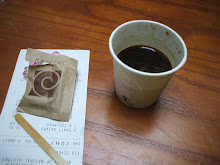YOU don't have to go that far south to find the South. Richmond, a mere two hours from Washington, has a magnolia-and-veranda-swing appeal that is worlds apart from anything even a little farther north. And notwithstanding its ties and testimonies to Robert E. Lee and other heroes of a long-lost world, Richmond today competes with Washington, its near neighbor, in up-to-date cultural sophistication.
You'd think based on this beginning that Lindsay Moran is going to delve into Richmond's odd balance between old South and new Metro. You'd be wrong.
In the subsequent grafs, she describes a couple of old-school southern food joints, and a new-school southern joint that is as much New York as it is Richmond. She manages to miss the southern joints that truly make the place--Croaker's and Millie's, to name two. Worse than that, you'd hardly know from Moran's article that the city has supported a strong dining scene since at least 1992.
For neighborhoods, she describes Monument Ave. in language ("The stately houses lining most of the street are Queen Anne, Victorian, Tudor, Colonial, Italianate, Greek Revival, and it's easy to imagine oneself as a guest, sipping refreshing libations on one of their gracious verandas.") that is remarkably close to the city's description of the neighborhood ("Federal, Greek Revival, Richardson Romanesque, Queen Anne, Tudor Revival, Spanish Colonial, Art Deco, and Italianate styles are all represented"). Her description of the Jefferson Hotel's history and inclusion also seems remarkably close to others I've read. Her descriptions of Shockoe Slip and The Bottom are similarly generic, and suggest to me that she never actually walked the streets or went to any of the restaurants.
The real kicker on neighborhood descriptions is her description of Carytown:
Browse the shops selling a variety of wares: estate antiques, beads and rocks, dolls and bears, designer cookies, and hats that only Southern women can get away with wearing
This description barely scratches even the western-most block in Carytown which is where these shops are, and does so in a way only a lazy travel writer could love. Never mind that Carytown is home to an excellent indie music store, a locally-owned toy store at the heart of one of the more heartbreaking stories in recent years, the classic Byrd Theater, a spin-off location of a local used bookstore, numerous restaurants and other truly funky retail. Never mind that the picture of Vivian Leigh touring Savannah that Moran seems to be trying to create has no place in Carytown.
Never mind all of that. Mind this: only a weak anecdote at the end of the story suggests to me that Ms. Moran actually visited Richmond. The rest of the article could have been (and I suspect was) written based on a few Google searches. It's a pity that someone was paid to do a hack job that wouldn't have passed muster in one of my comp courses. There are writers (including me) who would love to have put together a real article about Richmond.

